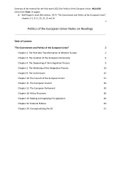Samenvatting
Summary Politics of the European Union Notes on Readings - GRADE 8,0
- Vak
- Instelling
- Boek
Summary of the material for the final exam (2022) for Politics of the European Union. INCLUDES notes from (Total: 53 pages): Neill Nugent’s book (8th edition, 2017) “The Government and Politics of the European Union”, chapters 2-5, 9-12, 18, 19, 22 and 24.
[Meer zien]




